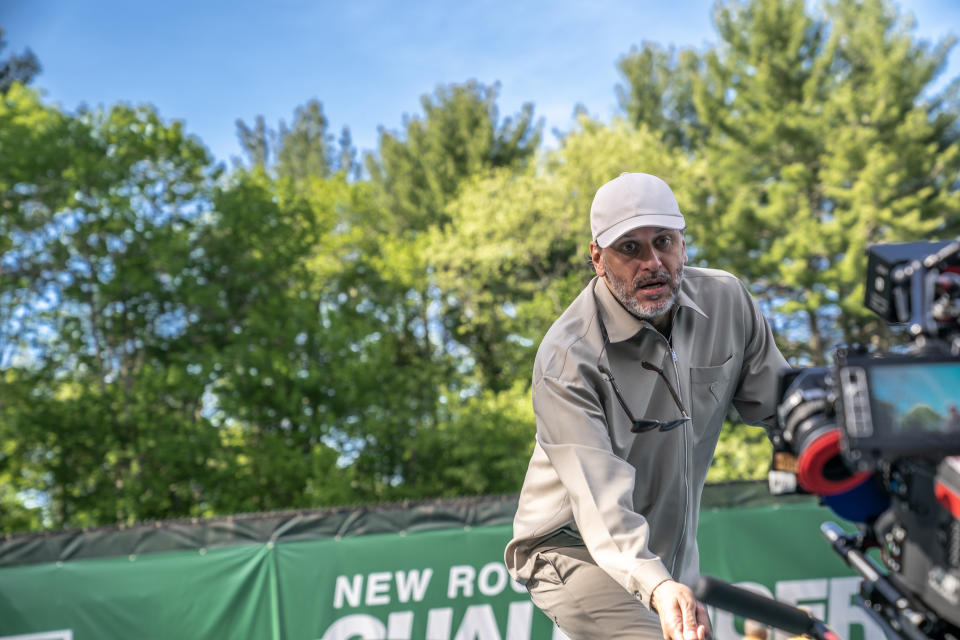‘Be the Ball’: Inside Those Crazy Tennis Ball POV Shots in ‘Challengers’

Right from its first scene, “Challengers” features some of the most cinematic and satisfying tennis we’ve seen on the big screen. Director Luca Guadagnino and cinematographer Sayombhu Mukdeeprom designed sequences that capture the competition, personal and sexual politics, and drama at play with each serve, volley, and backhand. The scenes are visceral, dynamic, and, at times, sexy.
But there is one particular tennis scene that really stands out, having been heavily discussed online, and proving to be both the film’s love it or hate it bold stroke, as well as the How the hell did they shoot that scene. In a key moment of a match between Art Donaldson (Mike Faist) and Patrick Zweig (Josh O’Connor) the camera adopts the point-of-view of the tennis ball — the camera flying, spinning, bouncing, as the ball is smacked back and forth between the two pro’s rackets.
More from IndieWire
With the film hitting PVOD this holiday weekend (it’s still in theaters, and you should absolutely see it there if you haven’t), “Challengers” visual effects supervisor Brian Drewes, of the Massachusetts-based Zero VFX, shared a before-and-after video and talked to IndieWire about how they executed the tennis ball POV.
You can watch the VFX break down below:
To execute the shot, the Drewes’ team actually filmed 23 individual shots with a camera (Arri Alexa LF) attached to a 30-foot technocrane flying back and forth over five hours on a tennis court. Those 23 shots were then stitched together to create the 24-second scene, with the VFX team adding 100-plus photoscanned background extras and the stands in their CG environment, as well as adding Faist and O’Connor’s faces and full rackets to the stand-in doubles. The scene would also require full CG takeovers to smooth the camera motion and lighting (time of day changes that happened while filming for five hours).
IndieWire emailed Drewes to learn more about how they pulled off this one-of-a-kind shot(s).
IndieWire: What did Luca initially say he was going for with this scene?
Drewes: In our very first meeting Luca described it super clearly: The audience needs to ‘BE THE BALL!!’ We talked about its significance in the film, (ifykyk), brainstorming cool moments to capture, and how we might transition from normal photography into this quite stylized sequence. From that conversation, I learned how kinetic he needed it to feel as an experience — it really was all in his mind’s eye quite early. This is absolutely what makes my job fun.
How did you determine and settle on the speed and movement of the ball? I’m just guessing, but considering the velocity at which pros now hit the ball, being 100 percent realistic would be too much, no?
The approach we found most successful was to start with an audio bed of an actual tennis volley from a pro match, which became our guide for real-world speed, and we built up from there. We very quickly realized abandoning reality was best when it came to topspin or backspin – we’d be talking the camera spinning at 2000-plus rpms, which would not be awesome for the audience.
Before filming, did you use previs, or some other tool, to make sure you were on the same page with Luca?
1000 percent. It was vital to build a solid plan of how and what we’d need to do to pull this off. In my experience the only real way to do this well, especially for what we were exploring, is visually.

Seeing the world through the lens of the ball, even in a rough 3D environment, gave us the ability to interactively experiment and find the really cool moments. Once you start building shot design and figuring out the rules, you quickly start learning what has potential and what doesn’t. By the first or second week of shooting the movie, we had an edit of this approved, and generally we followed it quite closely.
How did you shoot the actual shots?
Before shooting we broke the previs down into 23 discrete segments, all which needed to line up with each other. It definitely hurt my brain. To keep track, the VFX team at Zero had an editor on set to keep an up-to-date edit of what we were shooting, combined with the previs. This allowed me to know with confidence we were good to move on. The camera team did an especially awesome job on this film.
Though the main unit shot all with film, due to our specific needs, we shot digitally on the Alexa, off a pretty standard 30-foot crane.
Knowing you were going to stitch various shots, how did you approach the ball being hit? And what options did you leave yourself when shooting?
Our shooting took five hours to complete, but of course needed to appear continuous from a lighting perspective. This is tricky, but to get around it we did an extensive LiDar and photogrammetry scan of the court and its environment in a few lighting conditions.
This data allowed the artists at Zero to build a detailed, photoreal 3D world, allowing us to manage the lighting better and ensure perfect lineups between each of the 23 segments. Using this amalgam of real-world and digitally created footage, we added digital crowds, lens distortions, and of course continually working with Luca to dial in the camera pathing and visual nuances.
Best of IndieWire
Unsimulated Sex Scenes in Film: 'Nymphomaniac,' 'The Brown Bunny,' 'Little Ashes,' and More
Every Palme d'Or Winner from the Cannes Film Festival, Ranked
The 13 Best Thrillers Streaming on Netflix in May, from 'Fair Play' to 'Emily the Criminal'
Sign up for Indiewire's Newsletter. For the latest news, follow us on Facebook, Twitter, and Instagram.

 Yahoo News
Yahoo News 
